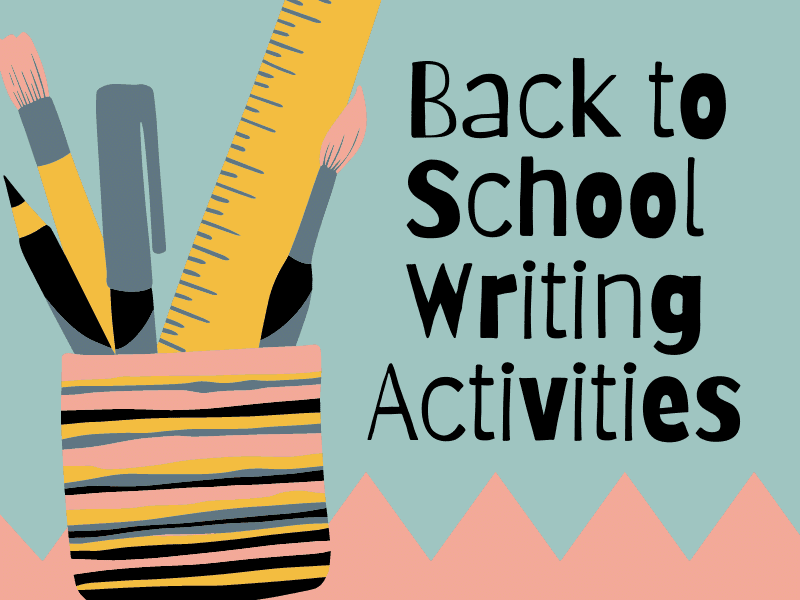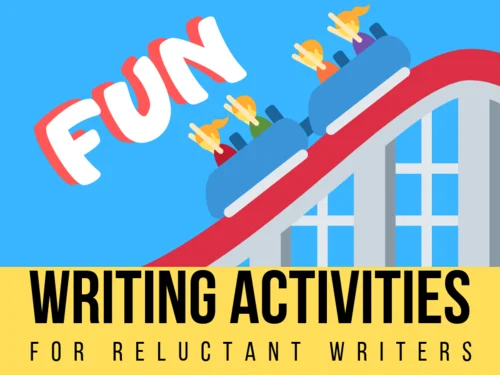
You might be a full-time classroom teacher who needs to take an unexpected day off and wants to keep their class busy and engaged in your absence.
In that case, you’ll need to devise straightforward yet stimulating activities for an off-the-cuff lesson plan.
Or, perhaps you’re that hardy breed of wandering samurai known as the substitute teacher. Either way, it pays to have a couple of fun, preplanned lesson plans and writing tasks quick to hand in case of emergencies.
Most battle-worn subs have a few rabbits they can pull from their magic hat immediately as and when the occasion calls for it. But it’s always good to mix things up a little and add a new trick or two to that trusty old bag of tricks.
In this article, we’ll explore seven fun writing tasks that promise to keep a room full of unfamiliar students equal parts engaged and entertained.
1. Pick and Mix

This activity requires a little preparation ahead of time. Still, your energy investment will be more than justified by the number of activities you can pull out of your hat instantly when needed.
To prepare for this activity, you’ll need to compile a list of well-known but seldom-used words. For example, while most 14-year-olds will know words such as missile, sorcerer, and miniature, they will most likely rarely use them in their writing.
The words you choose for your list will depend on the age of the students you’ll be teaching. As a sub, you might not always know what age group you’ll be teaching, so it’s worth preparing a few different lists for different age groups in advance. There are innumerable suitable word lists for each grade, a quick Google search away.
Once you have your word lists, type them and print them off. Cut out each word and place it in a small drawstring bag or similar container.
Then, when you need a spontaneous activity, pull out your bag and ask a student to pull out three words at random. The students must write a poem that incorporates the three chosen words.
There are many ways to adapt this central idea.
You can challenge the students to use their words to write a specific type of poem, e.g. sonnet, calligram, haiku, etc. Or, you might impose a time limit for the students to complete the task, e.g. 1 minute, 5 minutes, etc.
Perhaps you can ask them to collaborate in small groups to produce a shared writing piece. You can also ask them to choose different numbers of words or write in other genres, such as a short story or a dialogue.
The number of variations on this activity is limited only by your imagination.
2. Mystery Meal Review
In this activity, students will be challenged to use language to conjure up a mirage of a meal in the minds of their readers.
First, ask the students to think about the best meal they have ever eaten. Tell them to close their eyes to engage their imagination better. Instruct them to think about what they ate during that meal. Ask a series of rhetorical questions to help trigger their memories and inspire their creativity.
- What vegetables did they have?
- What type of meat was there?
- Was the food roasted? Fried? Boiled?
- Did they have sauces or seasonings?
- What was the texture of the food like in their mouths? Crunchy? Creamy? Melt in the mouth
- What colors were on their plate?
- How did the food smell?
Once they’ve had time to quietly reflect on the best meal they’ve ever eaten, it’s time to write about it. However, the twist in the tale here is that they cannot mention any of the food items they write about by name.
Instead, the students must describe the meal and its component items in such detail that the reader will be able to tell what they ate without the writer mentioning the food by name.
To make things a little easier, the students can use generic terms such as vegetable, meat, dessert, etc., but they must not use specific nouns such as chicken, carrots, gravy, etc.
This will challenge the student to use their powers of description to convey the details of their food to the reader. They’ll have to use sensory details appealing to the senses of sight, smell, taste, touch, and even sound.
When the students have finished writing their reviews of their best-ever meals, they can swap their descriptions with other classmates, who will then try to deduce the ingredients of their meal.
The winning writer will be the one with the most readers who correctly figure out the main elements of the writer’s meal.
3. Rewrite the Past

This activity is an excellent way to encourage the students to exercise their creativity while also instilling in the students the structure and features of recount writing.
To prepare for this activity, you’ll need to gather up a few old photographs to serve as visual stimuli for this writing activity. You can simply print these from the Internet. Alternatively, you can gather up a few props such as old postcards, an old-fashioned hat, a pair of spectacles, some old coins, etc.
Whatever the props used, students will employ them as a jumping-off point to kickstart their creativity as they write an imaginative first-person recount.
To revise the structure and features of a recount, check out our informative article here.
You can leave the background to their recount entirely up to the student and how they respond to the prompt. If you prefer, you can provide some context to the stimuli used, for example, in the form of some historical background or detail on who is in the photograph.
Either way, it will be incumbent upon the student to respond creatively to whatever prop you provide, all while considering the structural conventions and features of the recount text type.
If you wish to add a competitive element to the exercise, you might award a small prize for the most original, the funniest, etc.
4. Alternate Endings
Begin this writing activity by asking the students to name their favorite books or movies. Through a class vote, find the overall class favorite to base the activity on.
It doesn’t matter if some class members haven’t seen the movie (or read the book). You will start by retelling the story of the movie or book as a class. Pay particular attention to the ending. Make sure the class as a whole agrees on how the story comes to a climax and resolution.
Once this has been established, it’s time for students to kick their own pens into gear to write an alternative ending for the tale.

Encourage students to be as wacky and outlandish as possible. They can subvert the movie or book’s genre by tacking on a horror ending onto a comedy or vice versa, for example.
When students have completed their rewrite of the ending, encourage them to share their efforts with the class by reading their work out loud.
Which alternate ending did the class enjoy the most? Why?
5. Dialogue Reconstruction
Learning to write dialogue well is an effective way to breathe life into storytelling.
It takes practice and careful observation to develop the finely tuned ear required to write it well. This activity helps students to begin this process by carefully reconstructing a dialogue they overheard or participated in.
To get the ball rolling in this activity, first review the specifics of punctuating dialogue correctly. Do a little research to get up to speed if you are unsure about these rules. But, in brief, here are five of the most important of these rules:
- Introduce dialogue with a comma, e.g. She said, “The hat makes your head look small.”
- Use a comma when a dialogue tag follows a quote, e.g. “The hat makes your head look small,” she said.
- Place periods and commas within closing quotations, e.g. “It’s the hat that’s big, not my head.”
- Use single quotes when using quotes within dialogue, e.g. “My mother told me, ‘Your head is a perfect size, darling.’”
- Mark a change of speaker by starting a new paragraph, i.e. skipping a line. For example,
“The hat makes your head look small,” she said.
“It’s the hat that’s big, not my head,” he replied.
Technicalities out of the way, now it’s time for the students to get reconstructing!
Ask the students to think of a conversation they’ve had today. It might have been a trivial conversation they had with a parent over breakfast or with a friend or sibling on the way to school. Maybe it was some small talk with a worker in a shop. It doesn’t matter.
The task here is for the student to reflect on the conversation and attempt to recreate it on paper with as much faithfulness as possible.
Remind the students that we don’t speak as we write. Our spoken language is filled with half-finished sentences, slang, and non-standard pronunciations. Encourage students to accurately convey the rhythms and sounds of the speech they heard and/or uttered themselves.
This may require the students to veer from the usual grammar and spelling rules to render the dialogue convincingly.
Also, encourage the students to read their words aloud as they write to listen for their authenticity.
When students have finished, have them share their work with the class.
6. Found in Translation
This is a poetry writing activity, but with a twist.
Bring in a copy of a poem that is in a language other than English to show the students. Another European language will work best for this activity, as it is helpful if the students can make some educated guesses at the meanings of some of the words.
The students’ task will be to ‘translate’ the poem from a language they don’t read into English. Just in case some students do speak the language, be sure to have an alternative poem in another language to hand, too.
When you give the students the poem, don’t provide them with any background about the poem’s meaning.
Instead, tell them that they are to translate the poem into English. They can mimic the lines, spacing, and shape of the poem on the page. They can examine the words and attempt to deduce or guess at their meanings. Simply, they must do their best to interpret the poem and render its meaning on the page.
When the students have finished, have them share their work with the class and compare the wildly different interpretations of the original poem.
You might well be surprised at how close some students will come to the original subject matter!
Year Long Inference Based Writing Activities
Tap into the power of imagery in your classroom to master INFERENCE as AUTHORS and CRITICAL THINKERS.
⭐⭐⭐⭐⭐ (26 Reviews)
This YEAR-LONG 500+ PAGE unit is packed with robust opportunities for your students to develop the critical skill of inference through fun imagery, powerful thinking tools, and graphic organizers.
7. In Case of Emergency, Break Glass!

Writing prompts are the quickest, most straightforward way to get those pens moving and every sub worth their salt should have a few tried-and-tested prompts to hand at all times.
Here are five quick writing prompts guaranteed to get the ink flowing.
- You have a crocodile as a pet. Write about what it’s like to keep a croc as a household pet.
- You are going to interview your favorite celebrity. What questions do you ask?
- You have been appointed President of the World. What are the first laws you would change and why?
- Close your eyes, open a book and point at the page. Now, open your eyes again. What is the first word you see? Write about this word for five minutes.
- Write about ten things you could do to improve your life. Write about ten things you could do to improve the life of the people around you.
The Final Bell
So, there we have seven engaging writing tasks that make perfect additions to any sub’s bag of tricks. Each activity is quick and easy, with only a few requiring anything more than a minute or two in preparation in the form of easy-to-find materials.
Not only are these the perfect go-tos for any harassed substitute, but they are also useful to have in reserve for regular class teachers too. The teaching day is full of lots of little transitions, and it is always helpful to have a few quick, off-the-cuff activities to fall back on in such situations.









